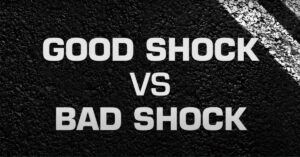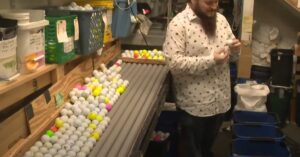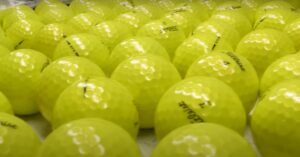Do Golf Balls Go Bad? Unveiling the Lifespan of Your Golfing Companions
Golf, a sport that has stood the test of time, captures the hearts of enthusiasts worldwide.
Among the essential components of a golfer’s arsenal, the humble golf ball plays a pivotal role in achieving optimal performance. But have you ever wondered if golf balls can go bad?
Golf balls do not technically go bad or expire like food or perishable goods do. However, their performance can deteriorate over time due to various factors such as usage, storage conditions, and the materials they are made of. The deterioration may affect their distance, spin, and overall feel.
In this blog post, we delve into the lifespan of golf balls and uncover the truth behind their longevity.
7 Signs That Indicate Golf Balls Have Gone Bad
Golf balls, like any other sports equipment, can deteriorate over time. While they may not have an expiration date, some signs indicate when golf balls have gone bad and should be replaced.
Here are some indicators to watch out for:
Exterior Damage
Inspect the golf ball for cracks, cuts, or significant scuffs on its outer surface. Damaged dimples can affect its flight and distance, making it less reliable during play.
Discoloration
Notice any changes in color on the golf ball’s cover. Fading or discoloration can be a sign of UV damage, which can negatively impact its performance.
Loss of Compression
Check for a loss of compression by squeezing the golf ball. If it feels noticeably softer or deflated, it may have lost its original performance characteristics.
Poor Balance
Spin the golf ball on a flat surface and observe its rotation. If it wobbles or has an uneven spin, it suggests a loss of balance, which affects accuracy and consistency.
Reduced Distance
If you notice a significant decrease in the distance your shots travel, it could be an indication that the golf balls have lost their elasticity or resilience.
Water Absorption
If golf balls have been exposed to water or moisture for an extended period, they can absorb it and become heavier, affecting their performance.
Age
Even if golf balls are not visibly damaged, they can lose their optimal performance characteristics over time. If you have older golf balls that have been stored for several years, consider replacing them for better playability.
Environmental Factors: Effects of Heat, Cold, and Humidity on Golf Balls
Golf is a sport that requires precision and control, and environmental factors such as heat, cold, and humidity can significantly impact the performance of golf balls.
Understanding how these factors affect the behavior of golf balls is essential for golfers aiming to optimize their game under varying conditions.
Effects of Heat on Golf Balls
Heat can have several effects on golf balls, altering their performance and behavior on the golf course.
High temperatures can cause the air inside the ball to expand, leading to increased pressure and potential loss of distance.
Additionally, heat can make the ball softer, resulting in lower compression and reduced energy transfer upon impact.
These factors combined can lead to decreased ball flight and overall performance.
Effects of Cold on Golf Balls
Cold temperatures also have a noticeable impact on golf balls. In colder conditions, the air inside the ball contracts, leading to decreased pressure and potential loss of distance.
Furthermore, the cold can make the ball harder and less resilient, increasing its tendency to feel harsh upon impact.
Reduced compression and decreased elasticity can result in a loss of feel and control, making it challenging to achieve consistent shots.
Effects of Humidity on Golf Balls
Humidity levels can influence the behavior of golf balls as well. In high humidity, the air is denser.
This can increase drag on the ball during flight, causing it to slow down and potentially reducing distance.
Additionally, increased moisture in the air can affect the ball’s surface, making it more prone to picking up dirt and debris, further impacting its performance.
Lower humidity, on the other hand, may result in increased ball speed and potential distance gains.
Adapting to Environmental Factors
To optimize their game under varying environmental conditions, golfers can make adjustments based on the effects of heat, cold, and humidity on golf balls.
When playing in hot conditions, selecting balls with higher compression and considering the potential distance loss can help compensate for the heat’s impact.
In colder temperatures, using balls with lower compression and focusing on maintaining proper swing mechanics and ball contact can aid in mitigating the effects.
In humid conditions, keeping the ball clean and selecting a higher-spinning ball can counteract some of the moisture-related challenges.
How To Tell If A Golf Ball Is Still Good?
If you have old golf balls that you no longer use or want, there are several options for what you can do with them:
Donate
Consider donating your old golf balls to local golf clubs, driving ranges, or youth programs. Many organizations accept used golf balls and can put them to good use for practice sessions or training programs.
Recycle
Golf balls are typically made from materials such as rubber and plastic, which can be recycled.
Check with your local recycling center or facilities that accept sports equipment to see if they have specific recycling programs for golf balls.
Repurpose
Get creative and find alternative uses for your old golf balls. They can be repurposed for various purposes, such as garden decorations, craft projects, or even as protection on the legs of furniture to prevent floor scratches.
Sell or Trade
If your golf balls are still in decent condition, you may consider selling them or trading them in at golf shops, online marketplaces, or sports equipment stores.
Some platforms specialize in buying and selling used golf balls.
Practice
If the balls are still suitable for hitting, you can keep them for personal practice sessions.
Practice shots in your backyard or at a driving range to work on your swing or experiment with different shots without worrying about losing expensive new balls.
Gift or Giveaway
If you have friends or family members who are avid golfers, you can offer your old golf balls as gifts or giveaways. They might appreciate having extra balls for their own practice or recreational play.
What To Do With Old Golf Balls?
If you have old golf balls that are no longer suitable for play, there are several options for what you can do with them:
Donate or Give Away
Consider donating your old golf balls to local charities, schools, or youth programs that may have a use for them. Many organizations appreciate golf balls for practice or fundraising events.
Alternatively, you can give them to fellow golfers who may find them useful for practice or casual play.
Repurpose for Practice
Even if the golf balls are no longer suitable for regular play, you can repurpose them for practice sessions. Use them for chipping, putting, or target practice in your backyard or at a designated practice area.
This way, you can continue to get value from them while improving your skills.
Sell or Trade
If your old golf balls are in decent condition and have some life left in them, you can sell or trade them.
Online marketplaces or local classifieds often have buyers interested in used golf balls.
Additionally, some golf shops or driving ranges may offer trade-in programs where you can exchange your old balls for credit toward new equipment or accessories.
Recycle
Golf balls are typically made of materials like rubber and synthetic polymers that can be recycled. Look for recycling programs or facilities in your area that accept golf balls.
They can be repurposed into various products or used for their raw materials.
Art and Crafts
Get creative and use old golf balls for art projects or crafts. They can be transformed into unique decorations, garden ornaments, or even incorporated into sculptures.
Explore DIY ideas and unleash your artistic side to give your old golf balls a new life as creative pieces.
Remember, if your old golf balls are still in good condition and suitable for play, you can also consider reselling them or offering them to others who might find them useful.
Are There Specific Types Of Golf Balls That Have A Longer Shelf Life?
Golf balls, regardless of their type, generally have a long shelf life if stored properly. However, certain golf balls may have features contributing to their durability and longevity. Here are some factors to consider:
Construction
Golf balls are typically constructed with different layers, including the cover, mantle, and core. Balls with a multi-layer construction tend to have better durability.
For example, urethane-covered balls are known for their resilience and longevity.
Compression
Golf balls come in different compression ratings, which affect their feel and performance. Higher compression balls often have a more solid construction, making them more durable over time.
Cover Material
The cover material can impact the durability of golf balls. Surlyn and urethane covers are commonly used.
Surlyn covers tend to be more durable and resistant to scuffs, while urethane covers offer enhanced spin and control but may be slightly less durable.
Quality and Brand
Golf balls from reputable brands often undergo rigorous testing and quality control measures to ensure their durability.
Established manufacturers invest in research and development to improve the longevity and performance of their products.
Tips for Extending the Lifespan of Golf Balls
To extend the lifespan of your golf balls and maximize their performance, consider the following tips:
Proper Storage
Store your golf balls in a cool, dry place at room temperature. Avoid exposing them to extreme heat or cold, as it can affect their performance and durability.
Ideally, keep them in a temperature-controlled environment, away from direct sunlight.
Avoid Water Exposure
Prevent prolonged exposure of golf balls to water or moisture. Water can seep into the ball’s core or cover, leading to damage or reduced performance.
If a ball gets wet during play, dry it thoroughly before returning it to your bag.
Use Ball Markers
When marking your golf ball on the green, use ball markers instead of sharp objects like tees or coins.
Avoid applying excessive pressure or using sharp tools that could potentially damage the ball’s surface or dimples.
Practice on Soft Surfaces
During practice sessions, try hitting your golf balls onto soft surfaces, such as grass or mats. Hitting them against hard surfaces like concrete or rocks can cause significant damage and reduce their lifespan.
Rotate Golf Balls
To distribute wear evenly, rotate the golf balls you use during play. By alternating between different balls in your bag, you can prevent excessive damage to a single ball and extend its collective lifespan.
Minimize Hazards
Avoid hitting golf balls into hazards like water, dense rough, or rocky areas. These environments can cause severe damage to the ball or make them difficult to retrieve.
Minimizing exposure to hazards will help preserve your golf balls.
Clean Golf Balls Properly
Regularly clean your golf balls to remove dirt, debris, and grass stains. Use a mild soap or golf ball cleaner and a soft cloth or brush to scrub the surface gently.
Rinse them thoroughly and dry them before storing them.
Inspect Regularly
Periodically inspect your golf balls for any signs of damage or wear. Look for cracks, cuts, or significant scuffs that could affect their performance.
Identifying any issues early on will allow you to retire damaged balls and replace them as needed.
Frequently Asked Questions
Discover answers to common inquiries regarding the lifespan of golf balls, their deterioration over time, and effective storage practices to maintain their performance on the course.
Can Old Golf Balls Affect My Game?
A: Yes, old golf balls may impact your game. Over time, golf balls can lose their elasticity, resulting in reduced distance and control.
Damaged covers or compromised cores can also affect the ball’s flight and feel. Using newer balls in good condition can help optimize your game.
How Can I Tell If A Golf Ball Is Still Usable?
Inspect golf balls for visible damage, such as cracks, cuts, or significant scuffs. Check the ball’s overall integrity by squeezing it gently.
If the ball feels excessively soft or hard, it may indicate a loss of performance. Properly stored and undamaged balls are generally usable.
Can Water Damage Affect Golf Balls?
Yes, water damage can affect golf balls. When submerged, water can seep into the ball’s core or cover, causing it to lose its performance characteristics.
It’s best to dry wet golf balls thoroughly and inspect them for any signs of damage before using them again.
Can Sunlight Affect Golf Balls?
Prolonged exposure to sunlight, specifically UV rays, can impact the performance of golf balls.
Sunlight can degrade the materials, making them more prone to scuffs, discoloration, and reduced elasticity. Store golf balls away from direct sunlight to maintain their quality.
How Should I Store Golf Balls To Maximize Their Lifespan?
Store golf balls in a cool, dry place away from extreme temperatures and direct sunlight. Keep them in airtight containers or bags to prevent moisture absorption.
Regularly inspect the balls for any damage or signs of wear and replace them if necessary to maintain optimal performance.
Conclusion
While golf balls may not technically “go bad” like perishable goods, their performance can degrade over time.
Factors such as usage, storage conditions, and the materials they are made of can impact their lifespan and effectiveness on the course.
To ensure optimal performance, golfers should consider replacing worn-out golf balls.




![What Are Golf Balls Made Off? [A Material Breakdown] american standard vs bryant (15)](https://giftedgolfers.com/wp-content/uploads/2023/06/american-standard-vs-bryant-15-300x157.jpg)

